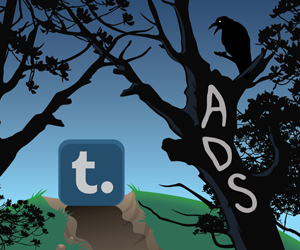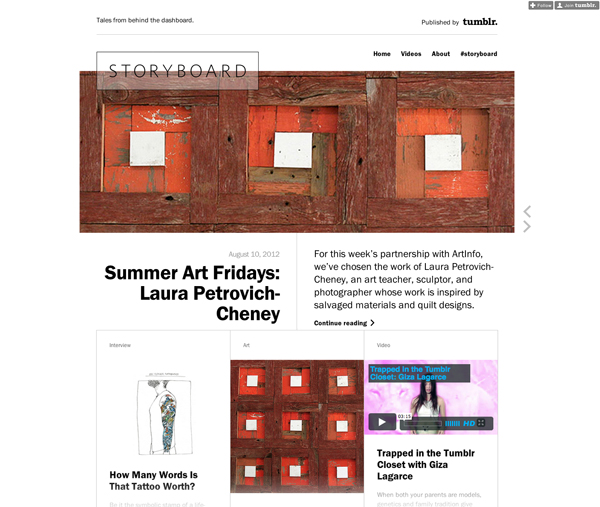 Tumblr is doing things differently. While Facebook and Twitter constantly load up on new features—many of which premiere to groans from avid users—Tumblr is scaling down and making things simpler in order to foster a positive artistic community. Tumblr also stands out by refusing to employ traditional digital-advertising methods. With more than 64 million blogs and 15 billion monthly page views, Tumblr could easily make millions through display, banner or video ads. But founder David Karp is sticking to his guns and rejecting anything he deems counter-creative. Instead he is focusing on a more holistic, integrated form of advertising wherein the brands involved must create great content on Tumblr. But given that the platform hosts edgy content (most recently, the disturbing “Holmies” sect) and is still largely pigeonholed as a place for fanatics and fanatical sharers, is this just wishful thinking?
Tumblr is doing things differently. While Facebook and Twitter constantly load up on new features—many of which premiere to groans from avid users—Tumblr is scaling down and making things simpler in order to foster a positive artistic community. Tumblr also stands out by refusing to employ traditional digital-advertising methods. With more than 64 million blogs and 15 billion monthly page views, Tumblr could easily make millions through display, banner or video ads. But founder David Karp is sticking to his guns and rejecting anything he deems counter-creative. Instead he is focusing on a more holistic, integrated form of advertising wherein the brands involved must create great content on Tumblr. But given that the platform hosts edgy content (most recently, the disturbing “Holmies” sect) and is still largely pigeonholed as a place for fanatics and fanatical sharers, is this just wishful thinking?
The Tumblr user demographic includes species such as The Fanboy, The Photographer and The Culture Blogger. It even includes some big brands, like Huggies and IBM, which are fostering new communities by publishing and curating content well—content that they have sufficient authority to publish in the first place. But then there are users whom no brand would ever wish to attract or choose to endorse, such as the Holmies, an alarming new group of Tumblr users who express love and support for Aurora, Colorado, murder suspect James Holmes on the platform through photos, GIFs and messages. It is easy to dismiss these people as some of the crazies ever-present on the outskirts of society, but their highly publicized story is now linked inextricably to the story of Tumblr. Their presence casts a shadow on the platform.
Attracting Real Advertising Revenue
A few months ago, Karp and company introduced Storyboard, an editors’ daily selection of the best blogs and stories on Tumblr that has included such brand sponsors as New York Magazine. It’s not a new feature so much as it is a popular new Tumblr blog that happens to have been created and to be curated by the platform bosses—a reflection of Karp’s integrated vision for advertising. So far they’ve created video, photo and text content that’s on a par with that of the best print publications. We are all for storytelling, and this effort seems to be a solid step for brands that have the right interests at heart, that encourage sharing and positivity; to prevent negative sentiment and spam, which would distract from the content, Tumblr’s pages (Storyboard included) do not even offer comment sections. The Storyboard homepage serves to ground wayward users, and it succeeds in catching some of the essence of the platform’s activity. So is Storyboard the best place for Tumblr advertisements?

The answer, for now, is yes. Karp once denounced advertising as sickening, but he is now more open to another form of moneymaking —a type of advertising that is “intended to make you feel something for the brand.” To foster creativity among the community, Karp’s platform will give brands “a spot on the Tumblr dashboard generally used to highlight the company’s picks for the coolest stuff happening in its network will include occasional content from paid sponsors,” writes Rob Walker in a spotlight in The New York Times Magazine. Thereby, Tumblr allows brands to be featured on the platform but still forces them to compete with average users for eyeballs. While Tumblr editors are putting in the time and paying the attention necessary to make Storyboard compelling, brands will have to create their own amazing content to grab the user’s attention. Inane couponing or cut-and-paste advertising will not thrive on this platform. To succeed in the Tumblr arena, brands must create artistic, cool, brand-authentic content. Consider IBM’s tumbling on science and technology and Huggies’ coverage of mom-related matters.
Karp has come up with a great plan for featuring brands while still maintaining the creative nature of the platform. And because its ad plan sticks to the platform’s roots, Tumblr’s diehard user base will play along. The question is, will brands bite? Will the Holmies and other weirdos scare them off, or will the possibility of a new audience entice them?
Is Multichannel the Answer?
Let’s take the example of another fringe brand, one that managed to thrive through advertising and expansion. Vice Media started as a little indie magazine in Montreal and has blossomed into an international company with wide appeal and financial success. Vice’s success stems from a multichannel approach that includes websites, live events, a magazine and three “verticals” for art, music and technology, notably the Creators Project, a close partnering with Intel. By segmenting itself and dealing separately with tamer new projects, the company is able to offer brands the benefits of being associated with Vice—its reputation as the edgy, authentic voice of cutting-edge youth culture is undeniable—without all the potential for blowback or risk that comes with certain channels, like the notorious Vice Magazine.
Will Tumblr embrace this model and segment itself into subcommunities under one umbrella in which brands play a key role in the creation process? Probably not, from what we know about David Karp’s staunchly minimalist approach. But perhaps the appeal of the Storyboard model—sponsorship of authentic editorial content—will be enough for brands who are willing to ignore the risks and focus on the large, carefully cultivated, unique audience at stake.
What do you think? Will brands embrace Tumblr and Karp’s plan? Or is the platform, by its very nature, a dead end for brand marketers?



Pingback: 3 Carmakers Embracing Brand Stories via @PostAdvertising
Pingback: Pinterest hasn’t killed tumblr… yet « Matt Maldre
Pingback: Pinterest hasn’t killed tumblr… yet | Matt Maldre